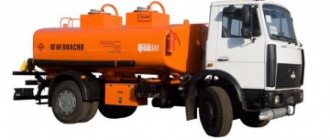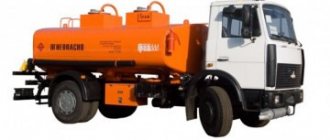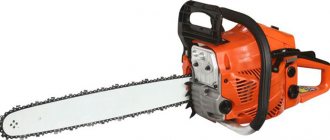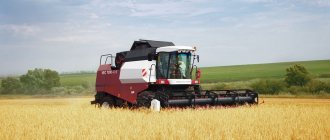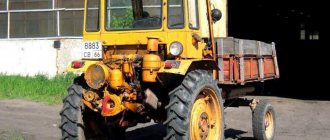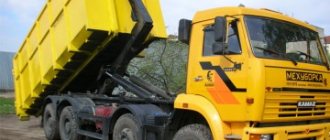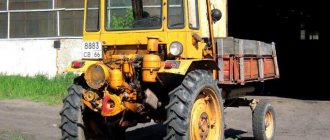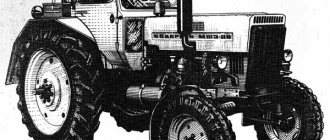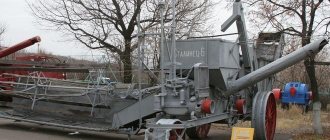Device
Externally, fuel tankers based on the GAZ-53 are distinguished by features characteristic of the brand and specific model - a small cabin with a long hood and protruding fenders, as well as an oval barrel with a pump. These units offer the user a number of possibilities, completely dependent on the technical configuration of the device:
- The installed ZMZ-53 engine (carburetor, 4-stroke, with 8 working cylinders) provides relatively high power for a medium-tonnage truck - 125 hp.
- The gearbox is designed for 5 speeds - 4 forward gears and one reverse.
- The chassis is represented by 2 axles with a 4*2 wheel formula and a dependent leaf spring suspension, equipped with telescopic shock absorbers to give the vehicle a smoother ride.
- Transmission mechanism – mechanical 4-speed.
- The steering is without power steering, which somewhat complicates control, but greatly simplifies the design.
- The brake system is drum type.
- The tank (barrel) is oval-shaped, welded from high-strength sheet steel, horizontally located, having internal stiffeners to increase its strength and safety of use (breakwaters prevent damage to the barrel due to both external mechanical influences and internal water hammer).
- The pump with which the tank is equipped is of a vane centrifugal type and is driven to the truck engine through the PTO.
Dimensions of the GAZ-53 fuel truck
ATTENTION! The carburetor engine of the “hard worker” requires a decent amount of fuel, so in order to save money, some models are equipped with MMZ D-245 diesel units.
Wiring diagram
The electrical circuit is powered by 12 V DC. The color electrical circuit includes the following basic elements:
- ignition system (distributor, ignition coil, spark plug switch);
- generator;
- starter;
- headlight lamps;
- rear lights;
- parking lights;
- turn signals;
- electrical part of the heating system;
- electric windshield wiper;
- sensors for monitoring the condition of machine components;
- steering column switches;
- sound signals.
All elements of the circuit are connected by a wire; there are fuses in the cabin that, if a short circuit occurs in the circuit, are triggered. The ignition system ensures ignition of the fuel mixture in the engine cylinders. The source of 12 V DC voltage is the battery. Power is turned on by turning the ignition key.
The voltage then goes to the low voltage circuit of the system. On distributor breakers, the magnetic field disappears at the moment the contact opens. The ignition coil converts the pulse into high voltage. The generator is three-phase, designed for a power of 560 W.
It produces alternating current, but since electrical equipment is designed for constant voltage, a rectifier is installed in the generator, which converts alternating current to direct current. This role is performed by a diode bridge.
The starter ensures uninterrupted engine starting in any weather. An important element of the starter is the relay, with the help of which the contacts of the starting mechanism are closed and the electrical circuit is turned on. Sensors monitor the operation of the engine and its systems. The instruments display all data in the cockpit with a description of the parameters.
See » Technical characteristics of the GAZ-53 dump truck and other modifications
Technical characteristics of electrical equipment:
- Rated network voltage is 12 V.
- Generator - G250-G2.
- Voltage regulator - 22.3702.
- The battery is 6ST-75.
- Starter - ST230-A1.
- Ignition coil - B116.
- Distributor sensor - 24.3706.
- Spark plugs - A11-30.
A transistor switch and an additional resistor are installed. Windshield wiper brand SL100. Headlights - FG122BV. Front lights - PF130. Rear lights - FP130B.
Description of GAZ-5312, photo
This is a flatbed, rear-wheel drive, hooded truck that was produced from 1983 to January 1993 (that is, it was the last in the family to be discontinued, giving way to the 3307 model). The cabin has rounded shapes throughout. There is not a single sharp corner in the exterior. The radiator grille, compared to earlier modifications, has become simplified. Complex stampings disappeared from it, but the number of holes remained the same. The exterior mirror housings have become plastic and increased in size.
The interior is a kingdom of bare metal. There is no upholstery of any kind (even the most modest) even on the interior door panels. There is minimal plastic here. There is no power steering at all, so turning the huge steering wheel requires remarkable strength. The speedometer occupies the central place on the dashboard. On the sides of it there are 4 more smaller devices, as well as several control lamps. Moreover, there is no tachometer. The ignition switch is also located here on the dashboard. In the middle of the panel there is a small drawer for small items. And on the right is a handle to hold on to.
Instead of separate armchairs, the “Lawn” had a one-piece three-seater sofa with a single back and pillow. Drivers used this if they wanted to sleep. The factory did not provide belts on the “53s” - then no one thought about safety in freight transport.
Exterior design and interior decoration
External changes affected the design of the radiator lining - the grille openings became oblong, the sidelights (turn signals and side lights) moved to the edge, and combined 2-lamp orange light diffusers appeared. Ergonomic driver and passenger seats are paired into one unit. It is quite comfortable to sit on them at any time of the year. The gas tank was placed under the driver's seat.
The installation of a panoramic windshield helped improve the visibility from the cab. Electric glass cleaners have been added. A year later, trucks began to be equipped with updated rear-view mirrors and three-layer wind windows. The cabin of cars of the 5312 family is unified. The dashboard of the first cars of this series was equipped with a clock, but did not contain an ammeter and an oil compression sensor - they were replaced by warning lights.
How to check the amount of fuel delivered
It is not uncommon for the amount of fuel actually delivered to differ from that ordered under the contract. If we are talking about several tons of product, losses can amount to a round sum. At first glance, it is impossible to check the volume of fuel, and we have to refuse to deliver diesel fuel in large quantities.
But there are several simple, proven ways to control the situation.
Types of automobile tanks
For petroleum substances, the tank is determined by the type of transport used to transport the filled container with dangerous goods. There are 2 main types:
- Tanks for general purpose petroleum products, also called universal;
- Tanks for railway purposes.
Universal models (number 1 in the list above) are further divided into 2 classes:
- For light petroleum products. Such containers transport diesel compounds, oil, gasoline (as well as its varieties), kerosene and derivative substances for a narrower purpose. For greater safety, such models are equipped with cap-type top liquid drain systems. They are not equipped with heating mechanisms for filling or draining the medium when the air temperature changes;
- For dark petroleum products. The models are used in the transportation of viscous compounds such as bitumen, fuel oil, petroleum, mineral oil and others. The system for draining liquid in such containers is installed in the lower part. Such containers have built-in heating systems. A level of 250 degrees Celsius eliminates all kinds of drainage delays, even if the ambient temperature is low. This function also helps bitumen trucks easily transport cargo over long distances.
It is fair to note that gas is an equally popular petroleum product. It is also transported in specialized containers, but under constant pressure. This is another class of equipment that is used no less often.
Important : in the production of models for light petroleum products, the most stringent safety requirements are always met. A classic tank for transporting gasoline is capable of transporting up to 5 variations of flammable liquid in one trip.
Fight for a lorry
Gas 51A was good for everyone and suited everyone. Its huge gas mileage and pre-war design with a lower-valve Dodge engine did not in the least bother the automotive companies where he worked, much less the manufacturers and management. The most inventive drivers installed carburetors from Gas-12 (Zim) on a low-power 70-horsepower engine, as a result of which the consumption increased even more and reached a cosmic 40 liters per hundred, but the power increased significantly. Some sources talk about an increase of 20 forces, but this is hard to believe.
Technical characteristics of GrAZ ATZ-36135-011 on the GAZ 3309 chassis
main engine transmission suspension and steering electrics performance characteristics brake system wheels and discs
| steering wheel location | left |
| Number of doors | 2 |
| number of seats | |
| Total | 2 |
| of them are inferior | 0 |
| design | frame |
| type | Piston |
| location | front, longitudinal |
| fuel | diesel |
| cooling | liquid |
| Gas distribution mechanism | SOHC |
| drive unit | rear |
| Transmission | Manual transmission |
| front suspension | |
| type of elastic element | spring on longitudinal semi-elliptic springs |
| guide vane type | dependent |
| shock absorbers | |
| adjustability | No |
| rear suspension | |
| type of elastic element | spring on longitudinal semi-elliptic springs |
| guide vane type | dependent |
| shock absorbers | |
| adjustability | No |
| on-board voltage | 24 V |
| Start-stop system | No |
| ABS | No |
| front brakes | |
| type | drums |
| material | metal |
| perforated | No |
| rear brakes | |
| type | drums |
| material | metal |
| perforated | No |
| disc material | steel |
www.autowp.ru
Where can I buy
We recommend purchasing a semi-trailer from official representatives of companies - this provides warranty service and protects against “cheat” by brokers. Pricing depends on the brand, year of manufacture and characteristics. On average, speaking about local producers, you can spend 1.5–2 million rubles.
If novelty is not important, take a closer look at sites for buying and selling equipment. Among the offers, you can really find good ones and buy a semi-trailer for 70–200 thousand rubles.
If you are purchasing equipment for a large enterprise, take a look at the offers of European manufacturers. Yes, prices there are much higher (15–23 thousand euros). However, quality and the latest technology will ensure the continuous operation of your organization.
We understand the types of semi-trailers and the features of transporting flammable goods. Now you know for sure how to comply with the rules of safe transportation and which model of tanker truck will suit our needs. All that remains is to purchase a semi-trailer.
Materials used
They say that the need for invention is cunning. And indeed, what kind of materials are not used in the manufacture of tanks! For products of the last decade, both in Russia and abroad, various types of steel are most often used: black carbon, stainless, low-alloy. But not only them. Manufacturers hold high-strength aluminum-magnesium alloy in high esteem. In general, the material from which a tank is made depends on the physical properties and mass of the product being transported, its area of application and, without fail, on climatic conditions. Just as you can’t make shoes that are equally suitable for the beach and the ice rink, you can’t build a tanker truck that will be as effective as possible both in the Far North and on the equator.
Tank characteristics
The material used to make the container is of great importance, since it largely determines the characteristics of the tank . Most often, these types of devices are made of stainless or structural steel, which ensures their strength and durability.
At the same time, there are alternative materials, for example, fiberglass or aluminum alloy, which are used much less frequently. The steel model has the heaviest weight, which can vary from 7 to 9 tons. The maximum volume of such a container is 50 thousand liters.
The aluminum tank is much lighter - about 5.7 tons, but has a large capacity of up to 36 thousand liters. It is important to remember that any materials other than fiberglass are used for transporting light petroleum products only.
Tank volume
As mentioned earlier, the volume of the container for transporting fuel directly depends on the material used, as well as the wishes of the customer. Standard models hold up to 30-50 thousand liters, which allows for the transportation of impressive volumes of cargo. In this case, it is possible to manufacture non-standard devices that will have the necessary characteristics and volume.
Gas 5312 and its differences
Gas 5312, the technical characteristics of which are given in the table, essentially remained the same 53rd lawn. Moreover, on its basis, until the very end of production, the 52nd was produced, which essentially repeated the design of the Gas 51, but had a new cabin. They even left the old worm-type main gear reducer, spur gearbox and lower valve motor.
In 1982, the quality mark disappeared from the front panel of the 53rd green. Whether this was some kind of symbol, or whether the Soviets simply had a shortage of plastic, is not known for certain, but immediately after this the plant modernized the car and in 1983 the Gas 5312 appeared. Externally, it is a copy of the old model, but some changes were made:
- the engine was modernized, now it was marked ZMZ 5311;
- the rear suspension design was strengthened;
- the frame received additional reinforcements;
- a leaf was added to the springs;
- Removed the trim from the front bumper.
Later, in 1986, the new car index was supported by an external update - the radiator lining was changed on both the 52nd and 53rd models, only on the 5312 the front stamped lining was painted white and light gray, and on the 52nd it was painted in cabin color. Around the same time, the car received a new color option - blue.
